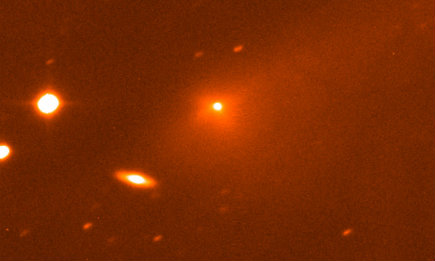Rosetta finally arrived

Today, after a decade-long journey through space, ESA’s Rosetta will become the first spacecraft in history to rendezvous with a comet. Since its launch from Europe’s Spaceport in Kourou, French Guiana on 2 March 2004, Rosetta has travelled more than six billion kilometers, passing by Earth three times and Mars once, and flying past two asteroids.
For the most distant part of the journey, when it travelled out to the orbit of Jupiter, Rosetta was put into deep-space hibernation for 31 months, waking up on 20 January 2014 for the final leg of its epic journey to Comet 67P/Churyumov–Gerasimenko. From today onwards, Rosetta will accompany the comet around the Sun and as it moves back out towards the orbit of Jupiter. The lander, Philae, will be delivered to the comet’s surface in November.
And when it has landed it will, just as the Rosetta Stone provided the key to an ancient civilization, unlock the mysteries of the oldest building blocks of our Solar System, the comets. As the worthy successor of Champollion and Young, Rosetta will allow scientists to look back 4600 million years to an epoch when no planets existed and only a vast swarm of asteroids and comets surrounded the Sun.
Answers to big questions
How life began on Earth is one of the most fascinating problems in modern science. Scientists are piecing together the evidence, and are showing increasing interest in the composition of comets. These icy leftovers from the formation of the planets may hold the key to unlocking the mysteries of life’s beginning. ESA’s comet chaser Rosetta is leading the quest to find out.
It seems highly unlikely that life in the form of biological cells began in comets. However, there is now very good evidence that some of the so-called chemical ‘building blocks’ of life – organic molecules – can be found in comets.
These chemicals can be seen using techniques such spectroscopy, in which light from the comet is split into a rainbow of colors and analyzed for the dark lines that the chemicals create. More importantly, it will be possible to carry out another technique called mass spectrometry with instruments on both Rosetta orbiter and lander. This will give even more accurate details of the comet’s chemical composition.
How did it all start?
In November 1993, the International Rosetta Mission was approved as a Cornerstone Mission in ESA’s Horizons 2000 Science Programme. Since then, scientists and engineers from all over Europe and the United States have been combining their talents to build an orbiter and a lander for this unique expedition to unravel the secrets of these mysterious ‘mini’ ice worlds.
Initially scheduled for January 2003, the launch of Rosetta had been postponed due to a failure of an Ariane rocket in December 2002. The adventure began March 2004, when a European Ariane 5 rocket lifted off from Kourou in French Guiana.
During a circuitous ten-year trek across the Solar System, Rosetta crossed the asteroid belt and travel into deep space, more than five times Earth’s distance from the Sun towards the comet. The Rosetta orbiter will rendezvous with Comet 67P/Churyumov-Gerasimenko and remain in close proximity to the icy nucleus as it plunges towards the warmer inner reaches of the Sun’s domain. At the same time, a small lander will be released onto the surface of this mysterious cosmic iceberg.
More than a year will pass before the remarkable mission draws to a close in December 2015. By then, both the spacecraft and the comet will have circled the Sun and be on their way out of the inner Solar System.
Here is all up-to-date information and a live stream about the Rosetta Mission
Meest Gelezen
Vrouwen houden universiteit draaiende, maar krijgen daarvoor geen waardering
Wederom intimidatie van journalisten door universiteit, nu in Delft
Hbo-docent wil wel rolmodel zijn, maar niet eigen moreel kompas opdringen
‘Burgerschapsonderwijs moet ook verplicht worden in hbo en wo’
Raad van State: laat taaltoets nog niet gelden voor hbo-opleidingen

